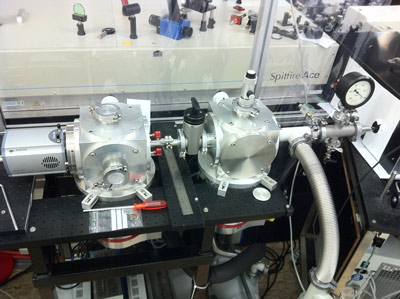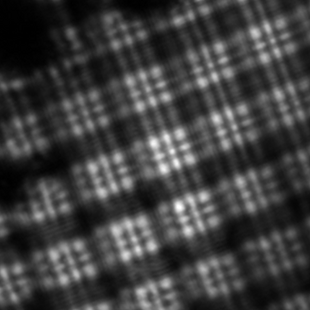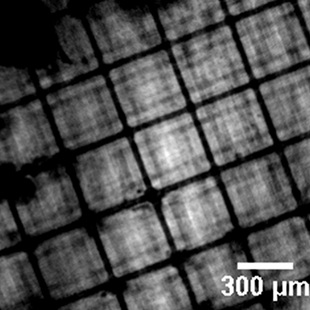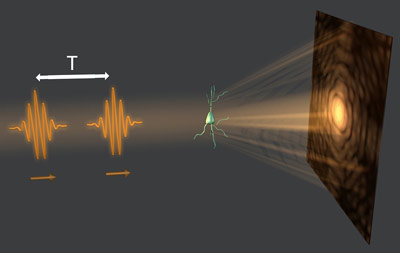Lensless coherence diffraction imaging – Application note

Fig. 2: Picture of the imaging setup as used in the experiment. The laser beam enters from the right side into a gas cell filled with xenon. The resulting XUV radiation enters a differentially-pumped vacuum chamber containing the nickel grid sample, and the resulting diffraction pattern is recorded with a back-illuminated XUV sensitive CCD camera
Soft-X-ray microscopy using atomic inner-shell excitations can provide a unique window into the structure and dynamics of the nanoworld.
Moreover, such short wavelengths can provide both spatial and spectroscopic information of nanoscale structures with high resolution. The water-window spectral range (2 - 4.5 nm wavelength) provides natural contrast for biology, allowing the imaging of intact cells. Imaging at such short wavelengths is challenging due to the lack of suitable imaging optics. Lensless imaging methods are a powerful alternative, but require coherent, monochromatic sources. These have mostly limited soft-X-ray imaging to large-scale facilities such as XFELs and synchrotrons.
At LaserLaB VU University Amsterdam, we have developed a method to perform lensless coherent diffractive imaging with broadband sources, which does not require spectral filtering or monochromators, and uses the full flux of the source efficiently [1]. It can therefore operate effectively with compact, table-top sources of extreme-ultraviolet (XUV) radiation based on high-harmonic generation (HHG). Our method employs two pulses with a tunable time delay between them, as schematically depicted in figure 1.
By recording a series of diffraction patterns of an object as a function of this pulse-to-pulse time delay, we obtain an interference pattern as a function of time delay at each camera pixel. Such an interference pattern encodes a Fourier-transform spectrum of the radiation that has diffracted onto that specific pixel.
From this data, we can retrieve spectrally resolved images throughout the entire source spectrum.
Setup
To demonstrate the feasibility of this approach, we set up a proof-of-concept experiment. The output of a Ti:sapphire amplifier system (~1 mJ, 40 fs pulses at 1 kHz repetition rate) was split into a coherent pair of pulses using a wedge-based common-path interferometer. This pulse pair was subsequently used for HHG in a gas cell filled with xenon. The produced XUV radiation emerges from the cell into a vacuum chamber through a small aperture to enable differential pumping between the gas cell and the imaging experiments.

Fig. 3: Broadband Fresnel diffraction pattern of a nickel grid in the energy
range of 19 - 27 eV (47 - 63 nm)

Fig. 4: Retrieved image of the grid at 47 nm wavelength, obtained using our two-pulse imaging method and multi-wavelength phase retrieval algorithm. The bars are 20 μm wide
An aluminium filter is used to separate the XUV radiation from the fundamental beam. On the aluminium filter, a nickel grid with 20 µm wide lines is placed, which does not transmit the XUV beam. The diffraction pattern from this grid is recorded using an iKon-M SO back-illuminated XUV-sensitive CCD camera (model DO934P-BN from Andor Technology). The camera contains 1024 x 1024 pixels with a pitch of 13 µm, and has a quantum efficiency of 20 - 40 % at the HHG wavelengths used in this experiment. The CCD records images of the sample in a transmission geometry. A picture of the vacuum system, featuring the iKon-M SO camera on the left, is shown in figure 2.
References
[1] S. Witte, V.T. Tenner, D.W.E. Noom, K.S.E. Eikema, “Lensless diffractive imaging with ultra-broadband table-top sources: from infrared to extreme-ultraviolet wavelengths”, Light: Sci. Appl. 3, e163 (2014).
[2] D.W.E. Noom, K.S.E. Eikema, S. Witte, “Lensless Phase Contrast Microscopy of Live Cells Using Fresnel Diffraction at Multiple Wavelengths”, Opt. Lett. 39, 193-196 (2014).



